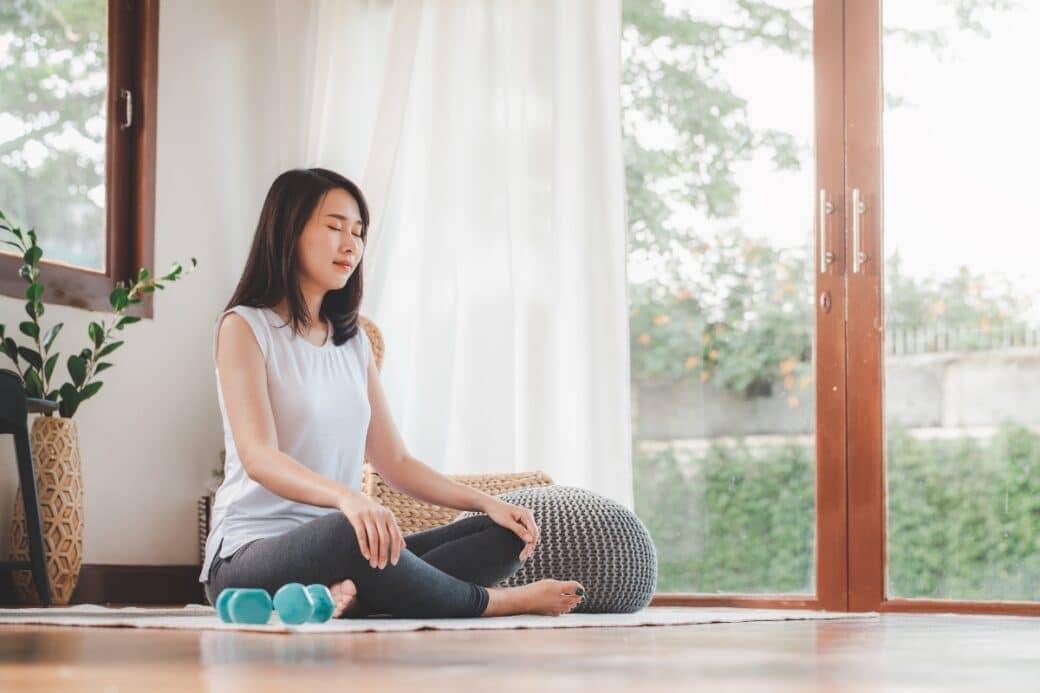Imagine being able to relax your mind, release stress, and achieve a restful night’s sleep, all from the comfort of your own bed. In this article, we will explore the secrets of meditating properly in bed and share some invaluable tips to help you attain the peaceful slumber you deserve. By incorporating simple meditation techniques into your nightly routine, you can create a tranquil atmosphere conducive to deep relaxation and rejuvenation. Say goodbye to restless nights and hello to blissful, uninterrupted sleep. It’s time to unlock the secrets of meditating properly in bed and embrace the transformative power of a good night’s rest.

Understanding the Basics of Meditation
What is meditation
Meditation is a practice that involves focusing your attention and eliminating the stream of thoughts that may be running through your mind. Contrary to popular belief, meditation is not about emptying your mind completely, but rather about observing your thoughts without judgment and allowing them to pass by. It is a state of deep relaxation and mental clarity.
Health benefits of meditation
Meditation has numerous health benefits that can positively impact both your physical and mental well-being. Regular meditation practice has been shown to reduce stress and anxiety levels, improve sleep quality, enhance focus and concentration, boost immune function, and increase feelings of happiness and contentment. It can also help lower blood pressure, improve cardiovascular health, and reduce symptoms of depression.
Common misconceptions about meditation
There are several misconceptions about meditation that may prevent people from trying it. One common misconception is that you need to be completely still and have no thoughts at all. In reality, meditation is about acceptance and non-judgment of your thoughts, rather than trying to eliminate them. Another misconception is that meditation is a religious or spiritual practice. While it can be a part of certain religious traditions, meditation can also be practiced by anyone, regardless of their beliefs. Lastly, many people believe that meditation requires a substantial time commitment. However, even just a few minutes of daily meditation can yield significant benefits.
Why Meditate in Bed
Convenience of bed meditation
One of the primary reasons to meditate in bed is the convenience it offers. Your bed is a familiar and comfortable space, making it easier to incorporate meditation into your daily routine. Whether you’re a morning person or a night owl, you can easily find a few minutes to meditate in bed before starting your day or winding down at night. You don’t need any special equipment or a dedicated meditation space – your bed is always accessible and ready for your practice.
Improving sleep quality
Meditating in bed has been found to improve sleep quality. By engaging in a calming meditation practice before sleep, you can relax your mind and body, reducing the likelihood of racing thoughts or anxiety interfering with your ability to fall asleep. This can be particularly helpful for those who struggle with insomnia or have difficulty quieting their mind at night. Bedtime meditation can create an environment conducive to deep relaxation, paving the way for a restful and rejuvenating sleep.
Easing into the day
Meditating in bed can also help you ease into the day with a sense of calm and focus. Instead of reaching for your phone as soon as you wake up, taking a few minutes to meditate in bed can set a positive tone for the rest of your day. It allows you to start your morning mindfully, promoting clarity, emotional balance, and a greater ability to handle stress. By establishing a meditative mindset before getting out of bed, you can approach the day with a sense of intention and purpose.
Preparing Your Bedroom for Meditation
Creating a serene environment
Creating a serene environment in your bedroom is essential for a peaceful meditation experience. Clear away any clutter or distractions that may hinder your focus. Decorate your space with soothing colors, soft lighting, and calming elements such as plants or natural materials. Consider incorporating aromatherapy by using essential oils known for their relaxing properties, such as lavender or chamomile. By curating a tranquil atmosphere, you can enhance the effectiveness of your bedtime meditation practice.
Ideal room temperature for meditation
The ideal room temperature for meditation can vary from person to person. However, it is generally recommended to keep the room slightly cooler than your regular daytime temperature. A cooler room temperature can promote a sense of calmness and relaxation, making it easier to settle into your meditation practice. Experiment with different temperatures to find what works best for you, ensuring that you are comfortable and not too hot or cold.
Importance of a comfortable bed
When meditating in bed, it is crucial to have a comfortable and supportive mattress. A quality, well-suited mattress can provide the necessary cushioning and alignment for your body, allowing you to sit or lay comfortably during meditation. Ensure that your pillow also provides adequate support for your neck and head. Comfort is key in creating a relaxing and distraction-free environment, enabling you to fully immerse yourself in your meditation practice.
Types of Bedtime Meditation
Mindfulness meditation
Mindfulness meditation involves focusing your attention on the present moment, cultivating a non-judgmental awareness of your thoughts, feelings, and bodily sensations. This meditation practice trains you to observe your thoughts without getting caught up in them, fostering a state of calm and mental clarity. Many find mindfulness meditation particularly beneficial for promoting relaxation before sleep.
Body scan meditation
Body scan meditation is a practice that involves systematically directing your attention to different parts of your body, bringing awareness to any sensations or tensions you may be feeling. This meditation technique is commonly used for deep relaxation and helps cultivate a greater connection between your mind and body. By scanning your body and releasing any tension, you can enter a state of profound calmness and prepare yourself for a good night’s sleep.
Visualization meditation
Visualization meditation involves creating vivid mental images to evoke specific feelings or sensations. By visualizing peaceful and positive scenes, such as serene natural landscapes or calming activities, you can promote a sense of relaxation and tranquility. Visualization meditation can be especially useful for bedtime, as it allows your mind to let go of any stress or worry and enter a more peaceful state before sleep.
Progressive muscle relaxation
Progressive muscle relaxation is a technique that involves systematically tensing and relaxing different muscle groups in your body. This practice helps release physical tension and promotes a deep sense of relaxation. By consciously tensing and then releasing specific muscle groups, such as your shoulders, hands, or legs, you can bring awareness to areas of tension and allow them to relax fully. Progressive muscle relaxation can be an effective way to prepare your body for a restful night’s sleep.
Optimal Meditation Positions in Bed
Laying flat on your back
Laying flat on your back is one of the most common meditation positions practiced in bed. It allows the body to fully relax and promotes a sense of stability and grounding. To assume this position, lie down comfortably on your back, ensuring that your body is aligned and supported by the mattress. Place your arms by your sides, palms facing up, and legs slightly apart. This posture allows for deep relaxation and is particularly suitable for body scan or visualization meditations.
Sitting up
Sitting up is another popular meditation position that can be adapted to bed meditation. It is ideal for those who prefer to engage in a more active meditation practice or have difficulty lying down for an extended period. To sit up in bed, find a comfortable position with your back supported by pillows or the headboard. Cross your legs or keep them extended in front of you, ensuring that your spine is straight. This posture encourages alertness and is conducive to mindfulness or breath-focused meditation.
Side pose
The side pose is a gentle meditation posture that can be practiced in bed, providing a comfortable alternative for those who find it challenging to meditate while lying flat or sitting up. To assume the side pose, lay on your side, with one arm bent and placed under your head as a pillow. Position your legs comfortably, allowing your body to relax into the mattress. This posture is particularly suitable for individuals who experience back pain or discomfort while meditating in other positions.
Child’s pose
Child’s pose is a restful and nurturing meditation position that can be practiced in bed. To assume child’s pose, kneel on the bed with your knees wide apart and your toes touching. Slowly lower your torso down to rest on your thighs, extending your arms forward or alongside your body. Allow your forehead to rest on the bed or a pillow if it is more comfortable. This posture promotes a sense of surrender, relaxation, and grounding, making it an excellent choice for pre-sleep meditation.
Cons of sitting crossed legged
While sitting cross-legged is a popular meditation position, it may not be suitable for everyone. Some individuals may find it uncomfortable or experience pain in their hips, knees, or ankles. It is essential to prioritize comfort and ease during meditation to avoid unnecessary strain or discomfort. If sitting crossed-legged in bed is not comfortable for you, consider exploring alternative postures like lying down or sitting up with the support of pillows.
Pre-Meditative Practices
Switching off electronic devices
Before starting your bedtime meditation, it is essential to switch off electronic devices such as phones, tablets, or laptops. The blue light emitted by these devices can interfere with your body’s natural sleep-wake cycle, making it more challenging to fall asleep. By disconnecting from screens and technology, you create a space free from distractions and allow your mind to settle into a state of relaxation.
Performing a self-care routine
Incorporating a self-care routine before meditation can further enhance the relaxation and mindfulness of your practice. Engage in activities that help you unwind and prepare for sleep, such as taking a warm bath, practicing gentle stretching or yoga, or engaging in a calming skincare routine. These self-care practices can help transition your mind and body from the busyness of the day to a state of calmness and tranquility, setting the stage for a restful meditation experience.
Drinking a calming herbal tea
Sipping on a calming herbal tea before meditation can be a soothing ritual that signals your body and mind that it is time to relax. Certain herbal teas, such as chamomile, valerian root, or lavender, have calming properties that can support your meditation practice and promote sleep. Brew yourself a warm cup of tea, find a comfortable spot in bed, and allow yourself to savor the flavors and aromas while preparing for your meditation.
Setting your intention
Setting an intention before your bedtime meditation can provide focus and direction to your practice. Consider what you hope to achieve or experience during your meditation – whether it’s cultivating a sense of peace, gaining clarity, or simply winding down after a long day. Reflect on your intention and carry it in your mind as you enter your meditation. This simple act of intention-setting can deepen your connection to your practice and enhance its effectiveness.
How to Meditate in Bed Properly
Closing your eyes
When you’re ready to begin your meditation in bed, gently close your eyes to minimize external distractions and bring your focus inward. Closing your eyes can help create a sense of internal stillness and promote deeper relaxation. Allow yourself to let go of any tension or strain in your eyes, and bring your attention to your breath.
Concentrating on your breath
Concentrating on your breath is a fundamental aspect of many meditation practices. Bring your awareness to the natural rhythm of your breath as it flows in and out of your body. Focus on the sensation of your breath, whether it’s the coolness of the inhale or the warmth of the exhale. Use your breath as an anchor to keep your attention in the present moment, letting go of any thoughts that arise.
Letting thoughts come and go
Throughout your meditation, thoughts will inevitably arise. Instead of resisting or judging these thoughts, cultivate an attitude of non-judgmental awareness and acceptance. Allow your thoughts to come and go, observing them without attachment or identification. If you find yourself getting caught up in a thought, gently redirect your attention back to your breath or the present moment.
Coming out of your meditation
When you feel ready to end your meditation, slowly bring your attention back to your surroundings. Wiggle your fingers and toes, stretch your body gently, and open your eyes. Take a few moments to acknowledge the stillness and calmness you have cultivated during your meditation before transitioning back into your daily activities. Carry the peace and clarity from your meditation with you as you navigate the rest of your day or prepare for sleep.
Addressing Common Meditation Problems
What to do when you can’t focus
It is common to experience difficulties in focusing during meditation, especially if you are new to the practice. When you find your mind wandering or becoming distracted, don’t be hard on yourself. Instead, greet those distractions with kindness and gently guide your attention back to your breath or chosen focal point. The practice of meditation is about constantly returning to the present moment, training your mind over time to stay focused for longer periods.
How to manage physical discomfort
Physical discomfort can arise during meditation, particularly if you’re in an uncomfortable posture or have underlying musculoskeletal issues. If you experience discomfort, experiment with adjusting your position or using additional cushions or support to alleviate the discomfort. It is crucial to prioritize your physical comfort during meditation to ensure a more enjoyable and sustainable practice.
Dealing with excess energy before sleep
Occasionally, you may find that your meditation leaves you feeling more energized or awake, making it challenging to fall asleep. In such instances, it can be helpful to engage in grounding practices after your meditation, such as gentle stretching, journaling, or reading a calming book. Additionally, implementing relaxing bedtime rituals, like having a cup of herbal tea or dimming the lights in your bedroom, can further encourage a transition into a calm and restful state before sleep.
Complimenting Your Bedtime Meditation with Other Practices
Benefits of yoga before sleep
Yoga is a complementary practice that can enhance the benefits of bedtime meditation. Gentle, restorative yoga poses, performed in a mindful and slow-paced manner, can prepare your body for relaxation and help release any physical tension or stress. Incorporating a short yoga sequence before your bedtime meditation can promote a deeper sense of calmness and facilitate a more restorative sleep.
Using aromatherapy for better relaxation
Aromatherapy can be a powerful tool to enhance the relaxation and effectiveness of your bedtime meditation. The use of essential oils known for their calming properties, such as lavender, chamomile, or sandalwood, can create a soothing atmosphere and deepen your state of relaxation. Consider using a diffuser or applying a few drops of essential oil to your pillow or bedding before meditation to tap into the therapeutic benefits of aromatherapy.
Sleep-inducing sounds and music
Incorporating sleep-inducing sounds or music can further enhance the tranquility of your meditation and promote a restful sleep. Soft, calming music or nature sounds can help drown out any external noises and create an atmosphere conducive to deep relaxation. Experiment with different sounds or guided meditation recordings to find what resonates with you and enhances your bedtime meditation experience.
Developing a Regular Bedtime Meditation Routine
Deciding on the best time for bedtime meditation
Finding the best time for bedtime meditation depends on your personal preferences and daily schedule. Some individuals may prefer to meditate shortly before sleep to promote relaxation and quiet the mind. Others may find that meditating earlier in the evening allows them to unwind and transition smoothly into their nighttime routine. Experiment with different times and observe how each affects your overall sleep quality and ability to relax.
Staying consistent with your routine
Consistency is key when developing a regular bedtime meditation routine. Aim to practice meditation at the same time each day, making it a non-negotiable part of your evening routine. By creating a habit, you signal to your mind and body that it is time to wind down and prepare for sleep. Consistency allows you to experience the cumulative benefits of meditation, including improved sleep quality and overall well-being.
Not getting discouraged by initial difficulties
When starting a bedtime meditation practice, it’s important not to get discouraged by initial difficulties. Meditation is a skill that takes time and practice to develop, and it’s natural to have moments of restlessness, racing thoughts, or difficulty focusing. Embrace these challenges with patience and compassion, knowing that each meditation session is an opportunity for growth and self-discovery. With consistent effort, you will gradually deepen your practice and experience its transformative benefits.
In conclusion, meditating in bed can be a convenient and effective way to incorporate mindfulness and relaxation into your daily routine. By understanding the basics of meditation, preparing your bedroom for your practice, and exploring different meditation positions and techniques, you can create a restful and rejuvenating meditation experience. Complementing your bedtime meditation with other practices like yoga, aromatherapy, and sleep-inducing sounds can further enhance your relaxation and promote a deeper, more restorative sleep. By developing a regular bedtime meditation routine and staying consistent with your practice, you can reap the many benefits of meditation and enjoy a peaceful night’s sleep. So, take some time for yourself, settle into your bed, and embark on a journey of self-discovery and inner tranquility through the practice of bedtime meditation.




